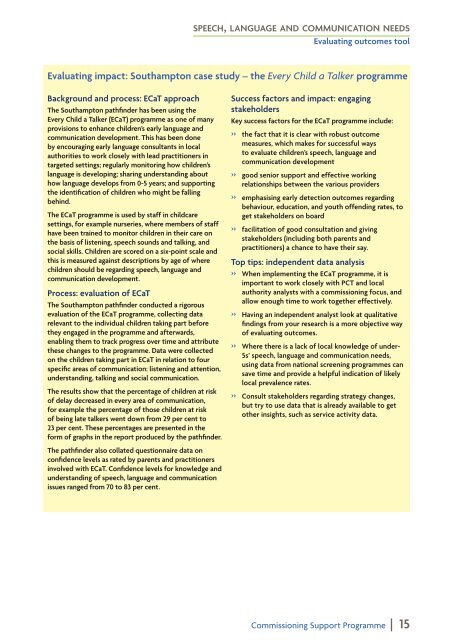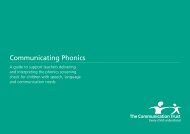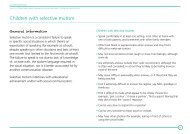Speech, language and communication needs: Evaluating outcomes ...
Speech, language and communication needs: Evaluating outcomes ...
Speech, language and communication needs: Evaluating outcomes ...
Create successful ePaper yourself
Turn your PDF publications into a flip-book with our unique Google optimized e-Paper software.
speech, <strong>language</strong> <strong>and</strong> <strong>communication</strong> <strong>needs</strong><br />
<strong>Evaluating</strong> <strong>outcomes</strong> tool<br />
<strong>Evaluating</strong> impact: Southampton case study – the Every Child a Talker programme<br />
Background <strong>and</strong> process: ECaT approach<br />
The Southampton pathfinder has been using the<br />
Every Child a Talker (ECaT) programme as one of many<br />
provisions to enhance children’s early <strong>language</strong> <strong>and</strong><br />
<strong>communication</strong> development. This has been done<br />
by encouraging early <strong>language</strong> consultants in local<br />
authorities to work closely with lead practitioners in<br />
targeted settings; regularly monitoring how children’s<br />
<strong>language</strong> is developing; sharing underst<strong>and</strong>ing about<br />
how <strong>language</strong> develops from 0-5 years; <strong>and</strong> supporting<br />
the identification of children who might be falling<br />
behind.<br />
The ECaT programme is used by staff in childcare<br />
settings, for example nurseries, where members of staff<br />
have been trained to monitor children in their care on<br />
the basis of listening, speech sounds <strong>and</strong> talking, <strong>and</strong><br />
social skills. Children are scored on a six-point scale <strong>and</strong><br />
this is measured against descriptions by age of where<br />
children should be regarding speech, <strong>language</strong> <strong>and</strong><br />
<strong>communication</strong> development.<br />
Process: evaluation of ECaT<br />
The Southampton pathfinder conducted a rigorous<br />
evaluation of the ECaT programme, collecting data<br />
relevant to the individual children taking part before<br />
they engaged in the programme <strong>and</strong> afterwards,<br />
enabling them to track progress over time <strong>and</strong> attribute<br />
these changes to the programme. Data were collected<br />
on the children taking part in ECaT in relation to four<br />
specific areas of <strong>communication</strong>: listening <strong>and</strong> attention,<br />
underst<strong>and</strong>ing, talking <strong>and</strong> social <strong>communication</strong>.<br />
The results show that the percentage of children at risk<br />
of delay decreased in every area of <strong>communication</strong>,<br />
for example the percentage of those children at risk<br />
of being late talkers went down from 29 per cent to<br />
23 per cent. These percentages are presented in the<br />
form of graphs in the report produced by the pathfinder.<br />
The pathfinder also collated questionnaire data on<br />
confidence levels as rated by parents <strong>and</strong> practitioners<br />
involved with ECaT. Confidence levels for knowledge <strong>and</strong><br />
underst<strong>and</strong>ing of speech, <strong>language</strong> <strong>and</strong> <strong>communication</strong><br />
issues ranged from 70 to 83 per cent.<br />
Success factors <strong>and</strong> impact: engaging<br />
stakeholders<br />
Key success factors for the ECaT programme include:<br />
»»<br />
the fact that it is clear with robust outcome<br />
measures, which makes for successful ways<br />
to evaluate children’s speech, <strong>language</strong> <strong>and</strong><br />
<strong>communication</strong> development<br />
»»<br />
good senior support <strong>and</strong> effective working<br />
relationships between the various providers<br />
»»<br />
emphasising early detection <strong>outcomes</strong> regarding<br />
behaviour, education, <strong>and</strong> youth offending rates, to<br />
get stakeholders on board<br />
»»<br />
facilitation of good consultation <strong>and</strong> giving<br />
stakeholders (including both parents <strong>and</strong><br />
practitioners) a chance to have their say.<br />
Top tips: independent data analysis<br />
»»<br />
When implementing the ECaT programme, it is<br />
important to work closely with PCT <strong>and</strong> local<br />
authority analysts with a commissioning focus, <strong>and</strong><br />
allow enough time to work together effectively.<br />
»»<br />
Having an independent analyst look at qualitative<br />
findings from your research is a more objective way<br />
of evaluating <strong>outcomes</strong>.<br />
»»<br />
Where there is a lack of local knowledge of under-<br />
5s’ speech, <strong>language</strong> <strong>and</strong> <strong>communication</strong> <strong>needs</strong>,<br />
using data from national screening programmes can<br />
save time <strong>and</strong> provide a helpful indication of likely<br />
local prevalence rates.<br />
»»<br />
Consult stakeholders regarding strategy changes,<br />
but try to use data that is already available to get<br />
other insights, such as service activity data.<br />
Commissioning Support Programme | 15

















